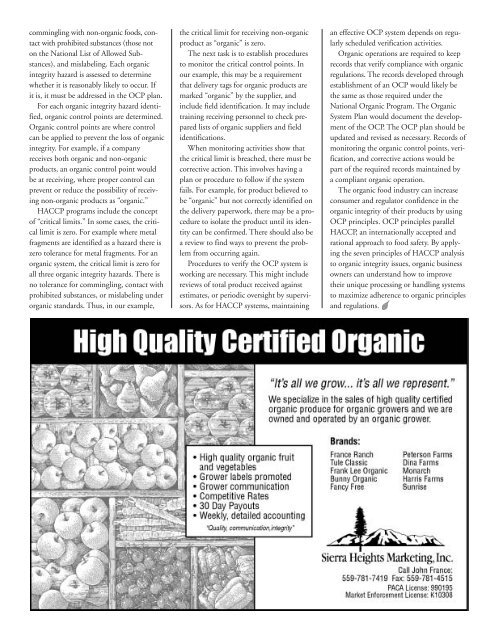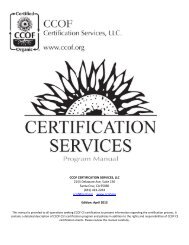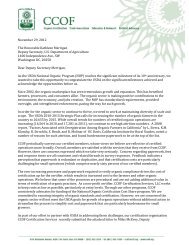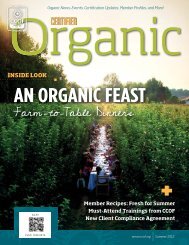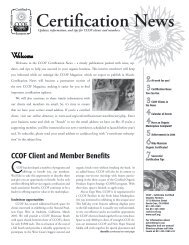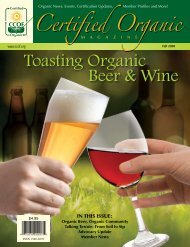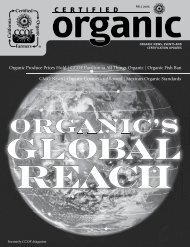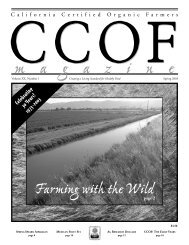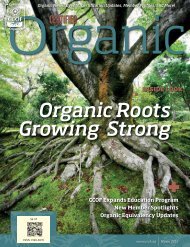Consolidation in Organic Agriculture - CCOF
Consolidation in Organic Agriculture - CCOF
Consolidation in Organic Agriculture - CCOF
Create successful ePaper yourself
Turn your PDF publications into a flip-book with our unique Google optimized e-Paper software.
comm<strong>in</strong>gl<strong>in</strong>g with non-organic foods, contactwith prohibited substances (those noton the National List of Allowed Substances),and mislabel<strong>in</strong>g. Each organic<strong>in</strong>tegrity hazard is assessed to determ<strong>in</strong>ewhether it is reasonably likely to occur. Ifit is, it must be addressed <strong>in</strong> the OCP plan.For each organic <strong>in</strong>tegrity hazard identified,organic control po<strong>in</strong>ts are determ<strong>in</strong>ed.<strong>Organic</strong> control po<strong>in</strong>ts are where controlcan be applied to prevent the loss of organic<strong>in</strong>tegrity. For example, if a companyreceives both organic and non-organicproducts, an organic control po<strong>in</strong>t wouldbe at receiv<strong>in</strong>g, where proper control canprevent or reduce the possibility of receiv<strong>in</strong>gnon-organic products as “organic.”HACCP programs <strong>in</strong>clude the conceptof “critical limits.” In some cases, the criticallimit is zero. For example where metalfragments are identified as a hazard there iszero tolerance for metal fragments. For anorganic system, the critical limit is zero forall three organic <strong>in</strong>tegrity hazards. There isno tolerance for comm<strong>in</strong>gl<strong>in</strong>g, contact withprohibited substances, or mislabel<strong>in</strong>g underorganic standards. Thus, <strong>in</strong> our example,the critical limit for receiv<strong>in</strong>g non-organicproduct as “organic” is zero.The next task is to establish proceduresto monitor the critical control po<strong>in</strong>ts. Inour example, this may be a requirementthat delivery tags for organic products aremarked “organic” by the supplier, and<strong>in</strong>clude field identification. It may <strong>in</strong>cludetra<strong>in</strong><strong>in</strong>g receiv<strong>in</strong>g personnel to check preparedlists of organic suppliers and fieldidentifications.When monitor<strong>in</strong>g activities show thatthe critical limit is breached, there must becorrective action. This <strong>in</strong>volves hav<strong>in</strong>g aplan or procedure to follow if the systemfails. For example, for product believed tobe “organic” but not correctly identified onthe delivery paperwork, there may be a procedureto isolate the product until its identitycan be confirmed. There should also bea review to f<strong>in</strong>d ways to prevent the problemfrom occurr<strong>in</strong>g aga<strong>in</strong>.Procedures to verify the OCP system iswork<strong>in</strong>g are necessary. This might <strong>in</strong>cludereviews of total product received aga<strong>in</strong>stestimates, or periodic oversight by supervisors.As for HACCP systems, ma<strong>in</strong>ta<strong>in</strong><strong>in</strong>gan effective OCP system depends on regularlyscheduled verification activities.<strong>Organic</strong> operations are required to keeprecords that verify compliance with organicregulations. The records developed throughestablishment of an OCP would likely bethe same as those required under theNational <strong>Organic</strong> Program. The <strong>Organic</strong>System Plan would document the developmentof the OCP. The OCP plan should beupdated and revised as necessary. Records ofmonitor<strong>in</strong>g the organic control po<strong>in</strong>ts, verification,and corrective actions would bepart of the required records ma<strong>in</strong>ta<strong>in</strong>ed bya compliant organic operation.The organic food <strong>in</strong>dustry can <strong>in</strong>creaseconsumer and regulator confidence <strong>in</strong> theorganic <strong>in</strong>tegrity of their products by us<strong>in</strong>gOCP pr<strong>in</strong>ciples. OCP pr<strong>in</strong>ciples parallelHACCP, an <strong>in</strong>ternationally accepted andrational approach to food safety. By apply<strong>in</strong>gthe seven pr<strong>in</strong>ciples of HACCP analysisto organic <strong>in</strong>tegrity issues, organic bus<strong>in</strong>essowners can understand how to improvetheir unique process<strong>in</strong>g or handl<strong>in</strong>g systemsto maximize adherence to organic pr<strong>in</strong>ciplesand regulations.


